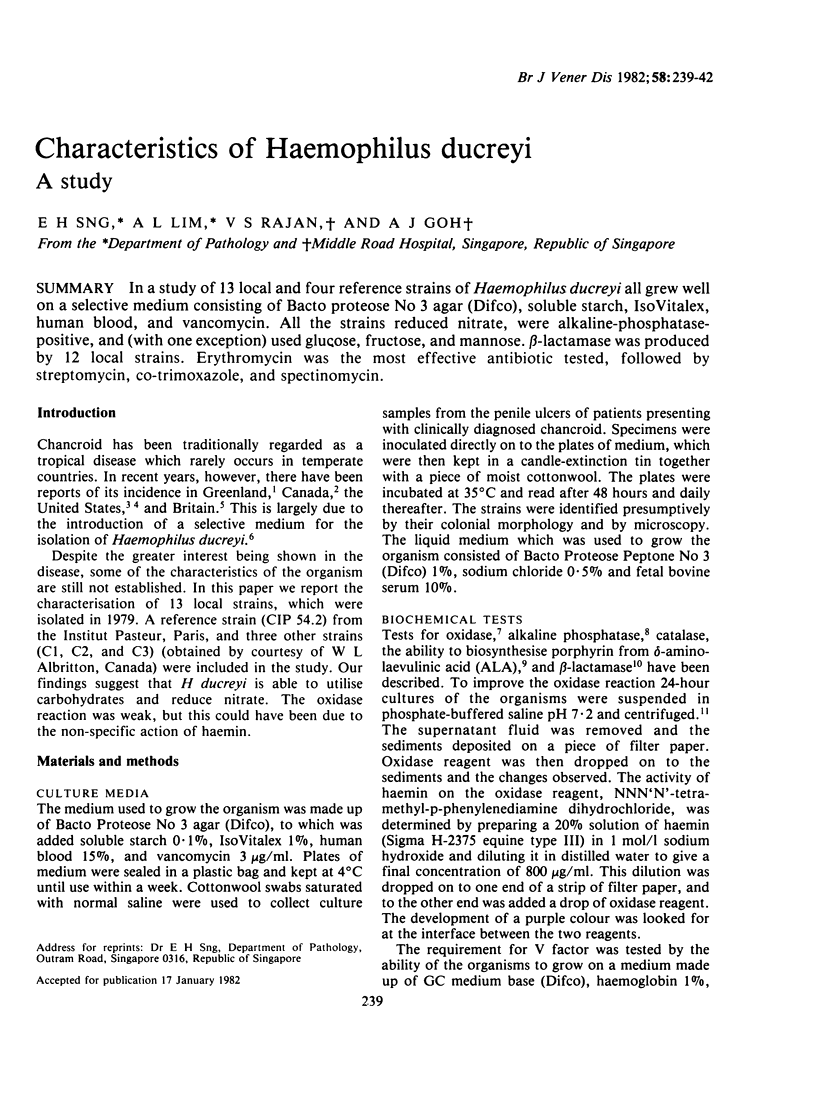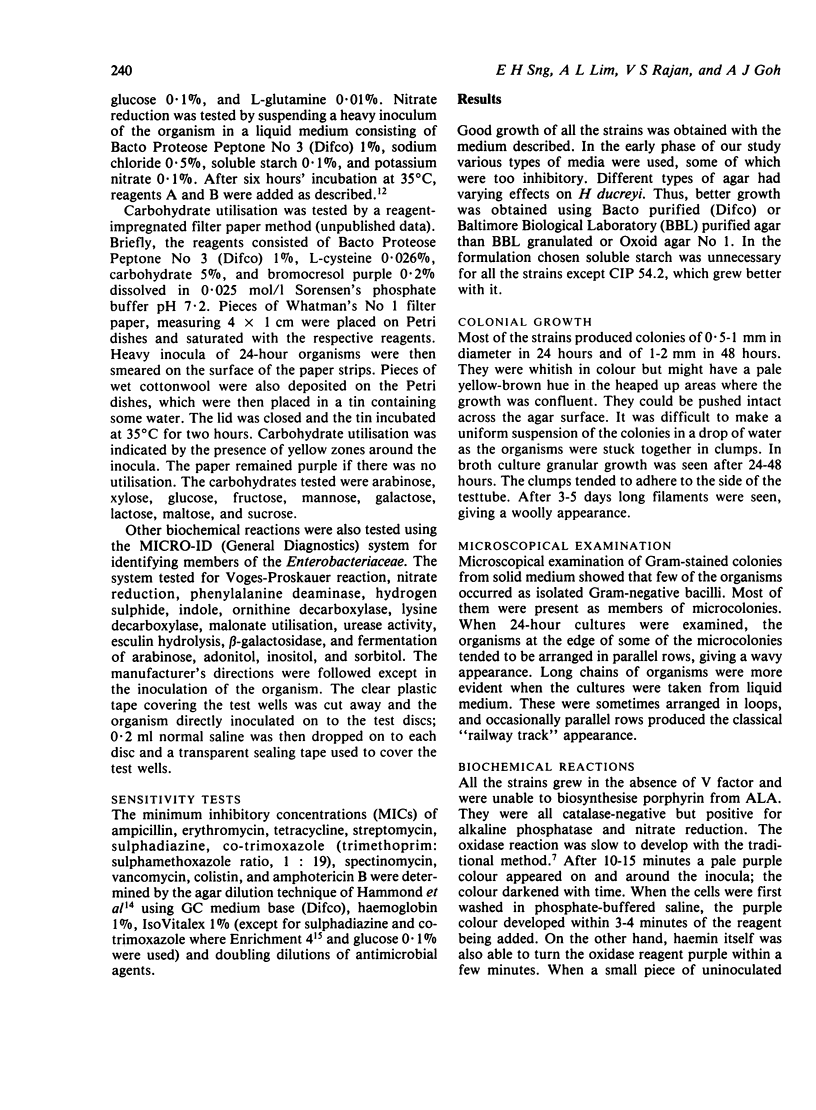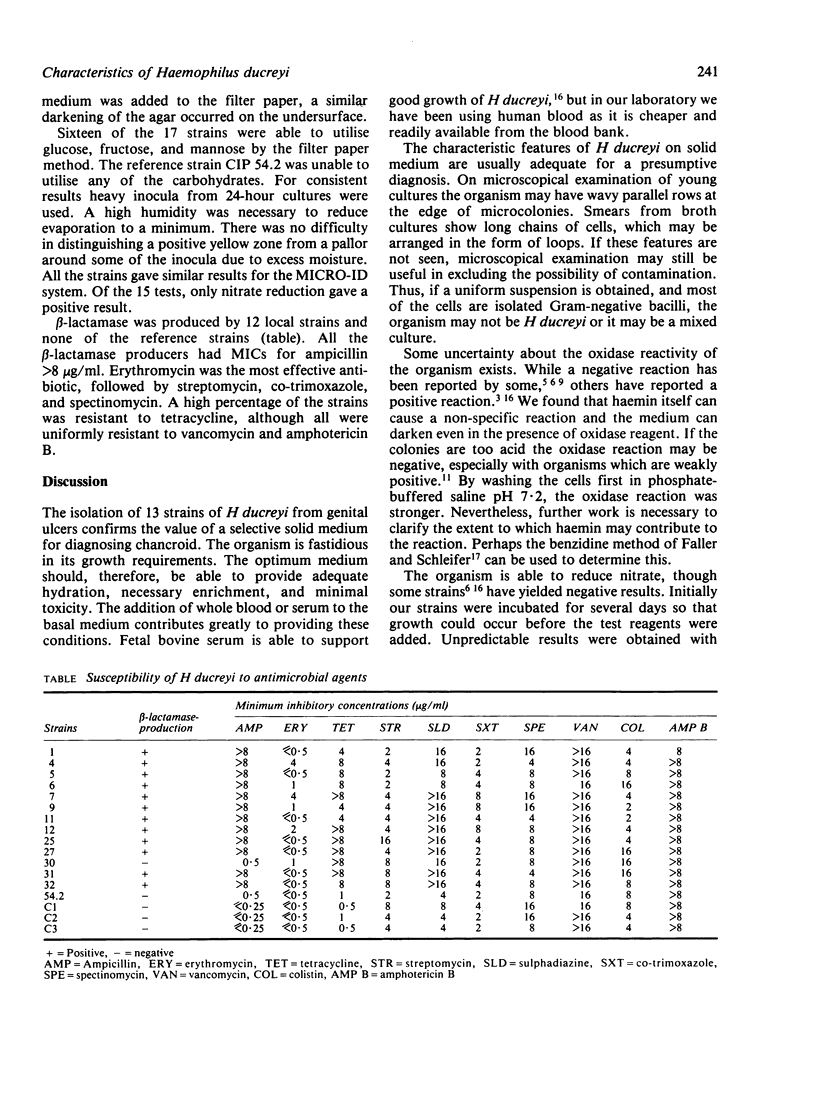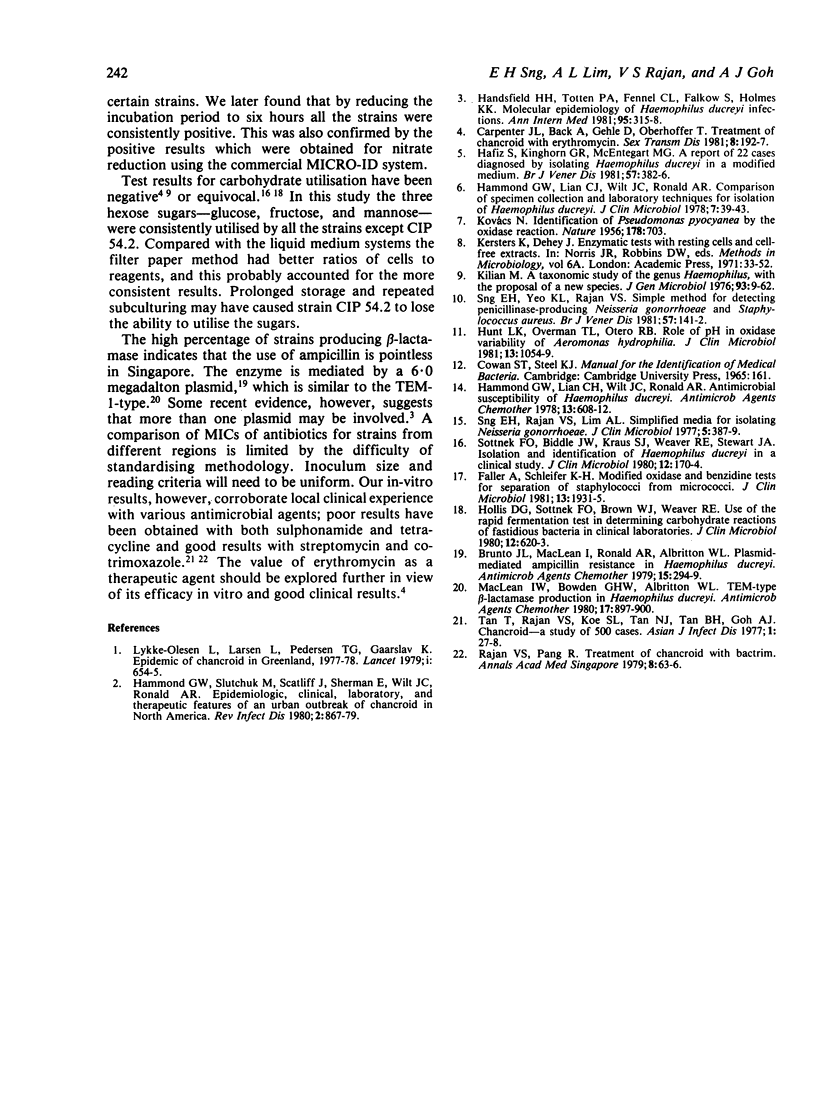Abstract
In a study of 13 local and four reference strains of Haemophilus ducreyi all grew well on a selective medium consisting of Bacto proteose No 3 agar (Difco), soluble starch, IsoVitalex, human blood, and vancomycin. All the strains reduced nitrate, were alkaline-phosphatase-positive, and (with one exception) used glucose, fructose, and mannose, beta-lactamase was produced by 12 local strains. Erythromycin was the the most effective antibiotic tested, followed by streptomycin, co-trimoxazole, and spectinomycin.
Full text
PDF



Selected References
These references are in PubMed. This may not be the complete list of references from this article.
- Brunton J. L., Maclean I., Ronald A. R., Albritton W. L. Plasmid-mediated ampicillin resistance in Haemophilus ducreyi. Antimicrob Agents Chemother. 1979 Feb;15(2):294–299. doi: 10.1128/aac.15.2.294. [DOI] [PMC free article] [PubMed] [Google Scholar]
- Carpenter J. L., Back A., Gehle D., Oberhoffer T. Treatment of chancroid with erythromycin. Sex Transm Dis. 1981 Jul-Sep;8(3):192–197. doi: 10.1097/00007435-198107000-00004. [DOI] [PubMed] [Google Scholar]
- Hafiz S., Kinghorn G. R., McEntegart M. G. Chancroid in Sheffield. A report of 22 cases diagnosed by isolating Haemophilus ducreyi in a modified medium. Br J Vener Dis. 1981 Dec;57(6):382–386. doi: 10.1136/sti.57.6.382. [DOI] [PMC free article] [PubMed] [Google Scholar]
- Hammond G. W., Lian C. J., Wilt J. C., Ronald A. R. Antimicrobial susceptibility of Haemophilus ducreyi. Antimicrob Agents Chemother. 1978 Apr;13(4):608–612. doi: 10.1128/aac.13.4.608. [DOI] [PMC free article] [PubMed] [Google Scholar]
- Hammond G. W., Lian C. J., Wilt J. C., Ronald A. R. Comparison of specimen collection and laboratory techniques for isolation of Haemophilus ducreyi. J Clin Microbiol. 1978 Jan;7(1):39–43. doi: 10.1128/jcm.7.1.39-43.1978. [DOI] [PMC free article] [PubMed] [Google Scholar]
- Hammond G. W., Slutchuk M., Scatliff J., Sherman E., Wilt J. C., Ronald A. R. Epidemiologic, clinical, laboratory, and therapeutic features of an urban outbreak of chancroid in North America. Rev Infect Dis. 1980 Nov-Dec;2(6):867–879. doi: 10.1093/clinids/2.6.867. [DOI] [PubMed] [Google Scholar]
- Handsfield H. H., Totten P. A., Fennel C. L., Falkow S., Holmes K. K. Molecular epidemiology of Haemophilus ducreyi infections. Ann Intern Med. 1981 Sep;95(3):315–318. doi: 10.7326/0003-4819-95-3-315. [DOI] [PubMed] [Google Scholar]
- Hollis D. G., Sottnek F. O., Brown W. J., Weaver R. E. Use of the rapid fermentation test in determining carbohydrate reactions of fastidious bacteria in clinical laboratories. J Clin Microbiol. 1980 Oct;12(4):620–623. doi: 10.1128/jcm.12.4.620-623.1980. [DOI] [PMC free article] [PubMed] [Google Scholar]
- Hunt L. K., Overman T. L., Otero R. B. Role of pH in oxidase variability of Aeromonas hydrophila. J Clin Microbiol. 1981 Jun;13(6):1054–1059. doi: 10.1128/jcm.13.6.1054-1059.1981. [DOI] [PMC free article] [PubMed] [Google Scholar]
- KOVACS N. Identification of Pseudomonas pyocyanea by the oxidase reaction. Nature. 1956 Sep 29;178(4535):703–703. doi: 10.1038/178703a0. [DOI] [PubMed] [Google Scholar]
- Kilian M. A taxonomic study of the genus Haemophilus, with the proposal of a new species. J Gen Microbiol. 1976 Mar;93(1):9–62. doi: 10.1099/00221287-93-1-9. [DOI] [PubMed] [Google Scholar]
- Lykke-Olesen L., Larsen L., Pedersen T. G., Gaarslev K. Epidemic of chancroid in Greenland 1977-78. Lancet. 1979 Mar 24;1(8117):654–655. doi: 10.1016/s0140-6736(79)91091-2. [DOI] [PubMed] [Google Scholar]
- MacLean I. W., Bowden G. H., Albritton W. L. TEM-type beta-lactamase production in Haemophilus ducreyi. Antimicrob Agents Chemother. 1980 May;17(5):897–900. doi: 10.1128/aac.17.5.897. [DOI] [PMC free article] [PubMed] [Google Scholar]
- Rajan V. S., Pang R. Treatment of chancroid with Bactrim. Ann Acad Med Singapore. 1979 Jan;8(1):63–66. [PubMed] [Google Scholar]
- Sng E. H., Rajan V. S., Lim A. L. Simplified media for isolating Neisseria gonorrhoeae. J Clin Microbiol. 1977 Apr;5(4):387–389. doi: 10.1128/jcm.5.4.387-389.1977. [DOI] [PMC free article] [PubMed] [Google Scholar]
- Sng E. H., Yeo K. L., Rajan V. S. Simple method for detecting penicillinase-producing Neisseria gonorrhoeae and Staphylococcus aureus. Br J Vener Dis. 1981 Apr;57(2):141–142. doi: 10.1136/sti.57.2.141. [DOI] [PMC free article] [PubMed] [Google Scholar]
- Sottnek F. O., Biddle J. W., Kraus S. J., Weaver R. E., Stewart J. A. Isolation and identification of Haemophilus ducreyi in a clinical study. J Clin Microbiol. 1980 Aug;12(2):170–174. doi: 10.1128/jcm.12.2.170-174.1980. [DOI] [PMC free article] [PubMed] [Google Scholar]


